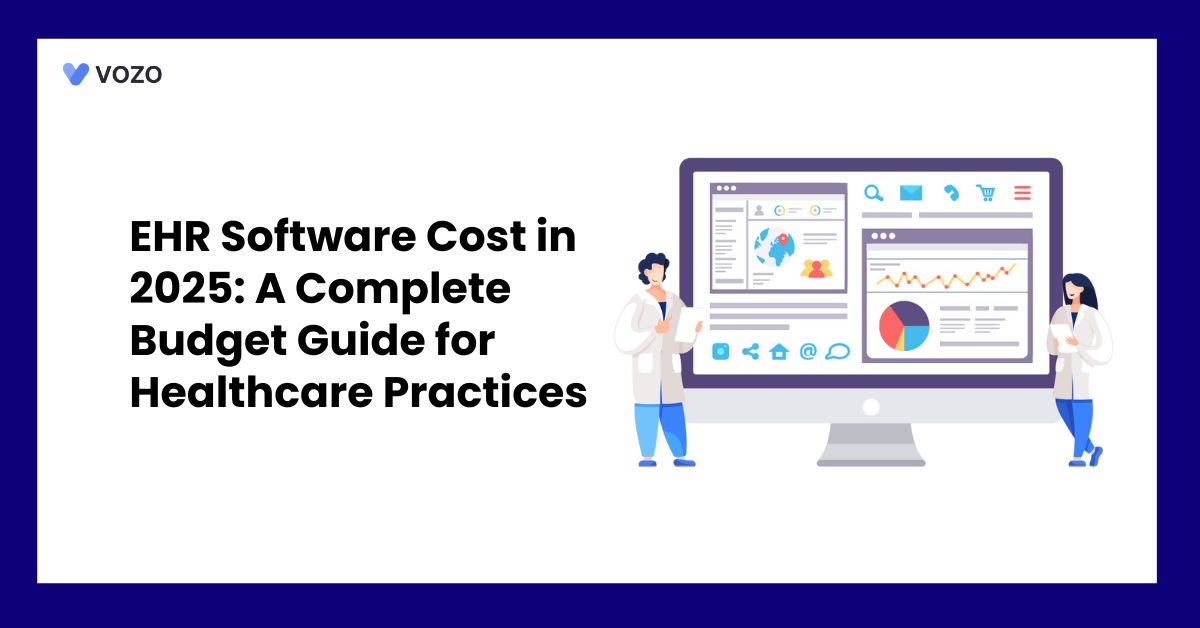EHR Software Cost in 2025: A Complete Budget Guide for Healthcare Practices
As healthcare organizations prepare for digital transformation in 2025, setting a realistic budget for EHR software is more crucial than ever. The global EHR market is estimated to rise from USD 28.6 billion in 2024 to USD 30.1 billion in 2025, with a CAGR of around 5.4%.
Recent industry research reveals that practices allocate an average of $6,000 per user for EHR software each year. In this blog, you’ll know the cost components and how to project your overall costs to avoid budget overruns and ensure long-term success.
Developing the Business Case for EHR Investment
Healthcare organizations are under pressure to modernize, streamline operations, comply with regulations, and improve patient outcomes. A substantial 38% of healthcare CIOs foresee EHR or EMR optimization as their main investment in the next three years.
- Improved operational efficiency through optimized workflows.
- Cost savings come from automated billing, fewer mistakes, and less paperwork.
- Revenue increased due to improved coding, higher billing accuracy, and faster claim response.
Academic data shows that a well-implemented EHR may yield net benefits of around $23,000 per full-time employee, with cost recovery generally occurring within 2.5 years.
Cost Components for EHR in 2025
EHR price is multidimensional, including license, installation, hardware, training, integration, and continuing maintenance.
1. Per-User License
The average annual license price ranges from $1,200 to $3,500 per individual. Smaller practices typically cost around $1,200/user/year, and big systems can cost up to $3,500/user/year.
Example: A practice with 3 doctors and 4 administrative users generally confronts ~$8,400/year in licensing, escalating over $10,000 with training.
2. Implementation and Setup
Core implementation includes installation and configuration costs of around $1,000-$3,000.
- For small clinics, the total implementation cost ranges from $20,000 to $65,000.
- Mid-size clinics range from $65K to $200K, while big hospitals may approach $650K.
- Large health systems like enterprise rollouts for networks of hundreds of providers may reach tens of millions, even $80 million or more.
Related: The Ultimate Guide to EHR Cost Savings: A Practical Roadmap for Healthcare Providers
3. Data Migration and Integration
Migration from older systems costs between $50,000 and $250, depending on the amount of data and its structure. Interface work (labs, radiology, and devices) requires additional development and middleware expenses.
4. Security and Compliance
Initial security audits, encryption architecture, and compliance validation might cost $5,000 to $20,000 per year. Ongoing yearly security maintenance, like security updates, audits, costs $10,000 to $50,000.
5. Training and Support
Initial training for each staff member costs between $1000 and $5,000. Annually, ongoing training (updates and refresher courses) costs $500 to $2,000 per staff member.
Additional vendor support services or optimization packages may incur an upgrade fee.
6. Hardware & IT Infrastructure
Cloud-based systems decrease initial IT expenditures but may result in continuous vendor overhead.
On-premise installations necessitate the use of servers, backup systems, and IT workers, which can cost tens of thousands of dollars at first.
How to Develop a Budget That Works
Take a progressive budgeting strategy. This is how each step progresses:
1. Define Scope and Objectives
- Determine which users and modules you require (such as scheduling, e-prescribing, and telehealth).
- Choose between cloud-based (SaaS) and on-premise deployments based on IT resources, security policies, and scalability.
2. Calculate Ongoing and Operational Costs
- Ongoing licensing fees, annual support, and security expenses.
- Training refreshers and upgrades. IT workforce and infrastructure renewal (on-premises).
3. Map ROI and Timeline
- Estimate how long it will take to obtain cost reductions (usually 2-3 years).
- Calculate the projected operational savings (less paperwork, improved billing efficiency).
- Estimate revenue increases (faster claims, better coding).
- Include these projections in your business case so that executives understand the road to ROI.
4. Choosing a Deployment Model
Cloud-Based (SaaS)
| Pros | Cons |
| Reduced upfront costs. | Higher lifetime licensing fees. |
| Vendor-managed updates and security. | Dependency on vendor service level agreements and uptime. |
| Simplified scaling and the go-live time are quicker. | Potential recurring costs per module/user. |
On-Premise EHR Systems
| Pros | Cons |
| A one-time licensing cost. | High upfront hardware and IT costs. |
| Complete control over data and security. | Needs internal IT support and continual maintenance. |
| Possible long-term cost reductions. | Upgrades may be disruptive and expensive. |
5. Hidden Costs and Practical Considerations
- Customization requests increase the cost of each template or specialty.
- Workflow disruptions affect the efficiency of some systems during changes
- Reporting and analytics with standards such as FHIR may need new development or subscription modules.
- Vendor lock-in ensures that data export and transition alternatives are available.
Related: The Hidden Costs of Staying on Legacy EHRs: Why 6-Figure IT Budgets Are Shifting Fast
6. Budgets by Organization Type
| Organization Type | Initial Budget Estimate (License + Setup) | Estimated Annual Operating Cost |
| Solo Practitioner | License: $1,200; Setup: $20K–$30K | $5K–$10K |
| Small Practice (5–10 users) | License: $6K–$12K; Setup: $30K–$65K | $15K–$30K |
| Mid-Sized Clinic | License: $20K–$35K; Setup: $65K–$200K | $50K–$100K |
| Large Hospital | License: $100K+; Setup: $200K–$650K+; Enterprise may exceed $80M | $500K+ |
Vozo Cloud EHR for your Healthcare Practices
From managing and organizing patient health records digitally to reducing medical errors, it significantly empowers providers to improve healthcare quality.
If you are searching for the best EHR system for your healthcare practice, Vozo EHR can be your go-to choice. Our comprehensive EHR solution lets you focus more on patient care while carrying all the burdens and simplifying them.
- Vozo Cloud EHR’s cost-effective cloud subscription benefits all levels of practice.
- Our feature-rich EHR helps you rectify mistakes efficiently and speed up the process.
- Vozo Specialty EHR resonates with specialty practice needs and requirements.
- Our expert technical team gets you covered 24/7 if any needs arise.
- Our EHR System continues to scale as your healthcare practice grows to improve the user experience.
The Vozo Customized EHR solution benefits your healthcare practice by:
- Streamlining the administrative process
- Improving workflow efficiency
- Reducing proneness to errors
- Managing all the patients’ records in one place
- Offers greater efficiency and cost savings across the board.
Our specialty-specific tools, like scheduling, patient portals, lab integration, cloud hosting, and more, meet your healthcare practice’s specific needs and requirements.
“Embrace Vozo EHR to reduce your burdens and enhance patient care.”
About the author

With more than 4 years of experience in the dynamic healthcare technology landscape, Sid specializes in crafting compelling content on topics including EHR/EMR, patient portals, healthcare automation, remote patient monitoring, and health information exchange. His expertise lies in translating cutting-edge innovations and intricate topics into engaging narratives that resonate with diverse audiences.













